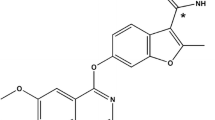Abstract
Purpose
This study investigated the metabolism and excretion of dovitinib (TKI258), a tyrosine kinase inhibitor that inhibits fibroblast, vascular endothelial, and platelet-derived growth factor receptors, in patients with advanced solid tumors.
Methods
Four patients (cohort 1) received a single 500 mg oral dose of 14C-dovitinib, followed by the collection of blood, urine, and feces for ≤10 days. Radioactivity concentrations were measured by liquid scintillation counting and plasma concentrations of dovitinib by liquid chromatography–tandem mass spectrometry. Both techniques were applied for metabolite profiling and identification. A continuous-dosing extension phase (nonlabeled dovitinib 400 mg daily) was conducted with the 3 patients from cohort 1 and 9 additional patients from cohort 2.
Results
The majority of radioactivity was recovered in feces (mean 61 %; range 52–69 %), as compared with urine (mean 16 %; range 13–21 %). Only 6–19 % of the radioactivity was recovered in feces as unchanged dovitinib, suggesting high oral absorption. 14C-dovitinib was eliminated predominantly via oxidative metabolism, with prominent primary biotransformations including hydroxylation on the fluorobenzyl ring and N-oxidation and carbon oxidation on the methylpiperazine moiety. Dovitinib was the most prominent radioactive component in plasma. The high apparent volume of distribution (2,160 L) may indicate that dovitinib distributes extensively to tissues. Adverse events were predominantly mild to moderate, and most common events included nausea, vomiting, constipation, diarrhea, and fatigue.
Conclusions
Dovitinib was well absorbed, extensively distributed, and eliminated mainly by oxidative metabolism, followed by excretion, predominantly in feces. The adverse events were as expected for this class of drug.




Similar content being viewed by others
References
Dvorak HF (2003) Rous–Whipple Award Lecture. How tumors make bad blood vessels and stroma. Am J Pathol 162:1747–1757. doi:10.1016/S0002-9440(10)64309-X
Haugsten EM, Wiedlocha A, Olsnes S, Wesche J (2010) Roles of fibroblast growth factor receptors in carcinogenesis. Mol Cancer Res 8:1439–1452. doi:10.1158/1541-7786.MCR-10-0168
Turner N, Grose R (2010) Fibroblast growth factor signalling: from development to cancer. Nat Rev Cancer 10:116–129. doi:10.1038/nrc2780
Fernando NT, Koch M, Rothrock C, Gollogly LK, D’Amore PA, Ryeom S, Yoon SS (2008) Tumor escape from endogenous, extracellular matrix-associated angiogenesis inhibitors by up-regulation of multiple proangiogenic factors. Clin Cancer Res 14:1529–1539. doi:10.1158/1078-0432.CCR-07-4126
Welti JC, Gourlaouen M, Powles T, Kudahetti SC, Wilson P, Berney DM, Reynolds AR (2011) Fibroblast growth factor 2 regulates endothelial cell sensitivity to sunitinib. Oncogene 30:1183–1193. doi:10.1038/onc.2010.503
Lee SH, Lopes de Menezes D, Vora J, Harris A, Ye H, Nordahl L, Garrett E, Samara E, Aukerman SL, Gelb AB, Heise C (2005) In vivo target modulation and biological activity of CHIR-258, a multitargeted growth factor receptor kinase inhibitor, in colon cancer models. Clin Cancer Res 11:3633–3641. doi:10.1158/1078-0432.CCR-04-2129
Trudel S, Li ZH, Wei E, Wiesmann M, Chang H, Chen C, Reece D, Heise C, Stewart AK (2005) CHIR-258, a novel, multitargeted tyrosine kinase inhibitor for the potential treatment of t(4;14) multiple myeloma. Blood 105:2941–2948. doi:10.1182/blood-2004-10-3913
André F, Bachelot TD, Campone M, Dalenc F, Perez-Garcia JM, Hurvitz SA, Turnere NS, Rugo HS, Baselga J, Zhang Y (2011) A multicenter, open-label phase II trial of dovitinib, an FGFR1 inhibitor, in FGFR1 amplified and non-amplified metastatic breast cancer. J Clin Oncol 29(Suppl 15):Abstract 508
Angevin E, Grünwald V, Ravaud A, Castellano DE, Lin C, Gschwend JE, Harzstark AL, Chang J, Wang Y, Shi MM, Escudier BJ (2011) A phase II study of dovitinib (TKI258), an FGFR- and VEGFR-inhibitor, in patients with advanced or metastatic renal cell cancer (mRCC). J Clin Oncol 29(Suppl 15):Abstract 4551
Kim KB, Chesney J, Robinson D, Gardner H, Shi MM, Kirkwood JM (2011) Phase I/II and pharmacodynamic study of dovitinib (TKI258), an inhibitor of fibroblast growth factor receptors and VEGF receptors, in patients with advanced melanoma. Clin Cancer Res 17:7451–7461. doi:10.1158/1078-0432.CCR-11-1747
Sarker D, Molife R, Evans TR, Hardie M, Marriott C, Butzberger-Zimmerli P, Morrison R, Fox JA, Heise C, Louie S, Aziz N, Garzon F, Michelson G, Judson IR, Jadayel D, Braendle E, de Bono JS (2008) A phase I pharmacokinetic and pharmacodynamic study of TKI258, an oral, multitargeted receptor tyrosine kinase inhibitor in patients with advanced solid tumors. Clin Cancer Res 14:2075–2081. doi:10.1158/1078-0432.CCR-07-1466
Wang X, Kay A, Anak O, Angevin E, Escudier B, Zhou W, Feng Y, Dugan M, Schran H (2012) Population pharmacokinetic/pharmacodynamic modeling to assist dosing schedule selection for dovitinib. J Clin Pharmacol Jan 27 [epub ahead of print]
Hamilton RA, Garnett WR, Kline BJ (1981) Determination of mean valproic acid serum level by assay of a single pooled sample. Clin Pharmacol Ther 29:408–413
Hartmann JT, Haap M, Kopp HG, Lipp HP (2009) Tyrosine kinase inhibitors—a review on pharmacology, metabolism and side effects. Curr Drug Metab 10:470–481
Acknowledgments
Supported by Novartis Pharmaceuticals Corporation. Financial support for medical editorial assistance was provided by Novartis Pharmaceuticals Corporation. We thank Peter J. Simon, PhD, and Leah Bernstein, PhD, ArticulateScience, for medical editorial assistance with this manuscript. In addition, AU and KK thank scientists in various departments at Novartis for providing radiolabeled study drug, metabolite synthetic standards, dovitinib plasma concentration data and supplemental metabolite structural data.
Author information
Authors and Affiliations
Corresponding author
Additional information
Anne-Charlotte Dubbelman and Alana Upthagrove are co-first authors.
Trial Registration: ClinicalTrials.gov number, NCT00669097.
Rights and permissions
About this article
Cite this article
Dubbelman, AC., Upthagrove, A., Beijnen, J.H. et al. Disposition and metabolism of 14C-dovitinib (TKI258), an inhibitor of FGFR and VEGFR, after oral administration in patients with advanced solid tumors. Cancer Chemother Pharmacol 70, 653–663 (2012). https://doi.org/10.1007/s00280-012-1947-2
Received:
Accepted:
Published:
Issue Date:
DOI: https://doi.org/10.1007/s00280-012-1947-2




